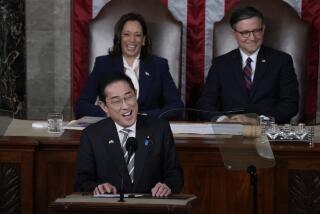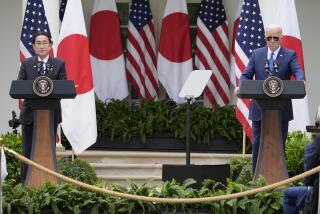Japan Joins List of Global Targets
- Share via
TOKYO — Japan joined the club of wary world powers this week after the capture by Peruvian guerrillas of hundreds of guests at a birthday party in Lima for Emperor Akihito demonstrated the frightening global ramifications of foreign policy lapses.
“Like America, Japan has made enemies without even noticing, and now it must protect itself,” said professor Koichi Oizumi, an international relations expert at Japan University. “We must take an ‘eye-for-eye, tooth-for-tooth’ attitude toward terrorism. We cannot be a victim.”
As the world’s largest donor of foreign aid, Japan is eager to shed the remnants of its postwar dependence on the United States and assume a global diplomatic role commensurate with its status as an economic superpower.
But the disastrous takeover of the Japanese ambassador’s residence in Lima and the seizure of hundreds of VIP hostages has shocked the public and prompted calls for Japan to review its security precautions and its program of overseas development assistance.
“It’s an important lesson to them, that when you pick sides in a developing country where guerrilla warfare is going on, you better be prepared to be a target,” said Edward J. Lincoln, who until August was special advisor to U.S. Ambassador Walter F. Mondale in Tokyo. “And they were woefully unprepared.”
A rebel from the Tupac Amaru Revolutionary Movement told Japanese TV that the guerrillas had targeted Japan because “the Japanese government is supporting [President Alberto] Fujimori, and Fujimori is ignoring the plight of 30 million hungry Peruvians.”
Japan has invested heavily in Peru, and, during a visit to Lima in August, Japanese Prime Minister Ryutaro Hashimoto approved a $549-million loan to fund rural hydroelectric, sewer and road development projects. In 1995, Japan also gave the Fujimori administration $66 million in direct foreign aid.
While the U.S. Embassy in Tokyo, one of the world’s more peaceful capitals, has a contingent of heavily armed Marines stationed inside, about 10 security guards and police patrolled the Japanese ambassador’s residence in Lima, including the ambassador’s bodyguards, according to Japanese news reports.
And the Lima facilities are among four of the best-protected Japanese embassies in the world, along with those in Cuba, the Philippines and El Salvador, according to reports here.
The Foreign Ministry said security had been increased in Lima after terrorist attacks in the early 1990s, including the slayings of three Japanese by Sendero Luminoso, or Shining Path, insurgents and a bomb attack on the Japanese Embassy.
The Tupac guerrillas infiltrated the Lima compound this week by posing as waiters, with explosives reportedly stashed inside a cake. Their comrades then blasted a hole through the 15-foot-high compound wall that had recently been topped with barbed wire.
“It would have been rather embarrassing to conduct body searches on the guests arriving for the emperor’s birthday party, so in that sense, perhaps security was lax,” said Masayuki Tomizawa of Intersec, a security firm that protects Japanese executives abroad.
Despite their growing influence and affluence, many Japanese still underestimate what attractive targets they offer criminals and terrorists and do not take sufficient responsibility for their own security, Tomizawa said, noting: “The Japanese Embassy invited all these important people and had a duty to protect them.”
Since Japan’s “Peace Constitution” prohibits the Japanese from sending troops abroad, Tomizawa proposed that Japan send specially trained police details to properly protect its embassies or hire foreign SWAT teams for the job.
Atsuyuki Sasa, former head of the Cabinet Office of Security Affairs, rejected the notion that security had been lax and said it was the Peruvian police who had ultimate responsibility for protecting the Japanese compound.
“It’s cruel to blame the Japanese Embassy for lax security after this incident,” he said.
Cruel or not, Japan will face a diplomatic debacle, as well as a human tragedy, if any of the ambassadors and other foreign VIP hostages are harmed, Oizumi said.
Hashimoto’s decision to send Foreign Minister Yukihiko Ikeda to Lima is a rare move that shows the severity of the crisis, he said.
Since the ambassador’s residence is considered Japanese soil under international law, Tokyo would theoretically have to give its OK before Peruvian troops could storm the compound--if a rescue attempt is deemed necessary. “Fujimori is caught between America and Japan,” Oizumi said. “America does not want to tolerate terrorism; Japan is anxious to protect the human lives.”
Fujimori and Hashimoto were holding their cards closely Thursday, making it impossible to know whether either government was inclined to attack or give ground to the terrorists.
Lincoln, now a senior fellow at the Brookings Institution in Washington, said the Japanese response to previous terrorist attacks has been “to be frightened and run around like chickens with their heads cut off because they don’t have any policy, and in the end, they cave in and do whatever the terrorists want.”
Asked whether Japan has learned from past mistakes and is likely to handle the Peru standoff more effectively, Lincoln replied: “No.”
Other analysts said that whatever the outcome of the hostage crisis, Japan is unlikely to scale back its aid to Peru because of its ethnic sympathies with the estimated 50,000 Peruvians of Japanese ancestry--including Fujimori.
More to Read
Sign up for Essential California
The most important California stories and recommendations in your inbox every morning.
You may occasionally receive promotional content from the Los Angeles Times.










